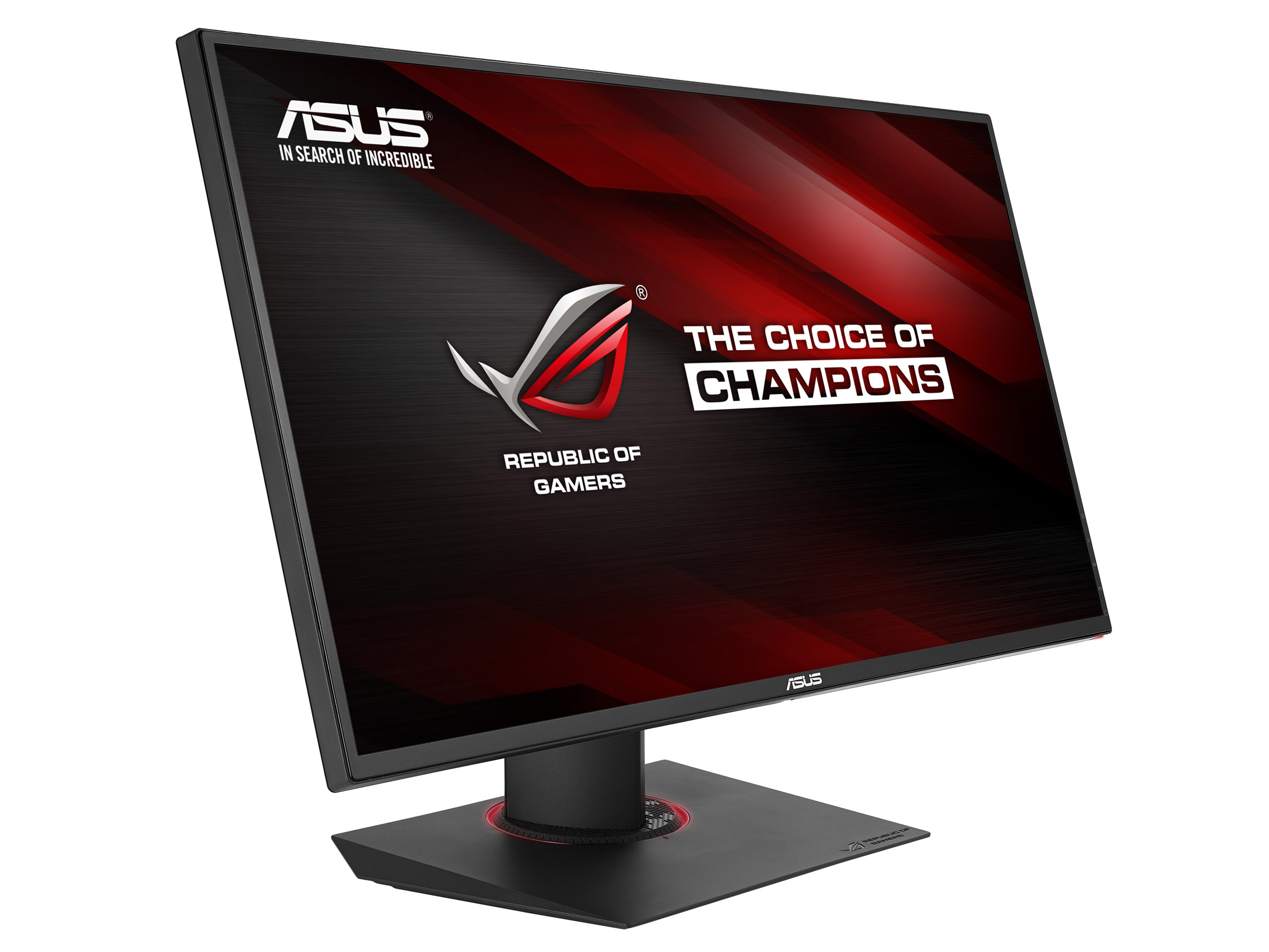Asus Republic of Gamers G-Sync Monitor Arrives in August
Asus Republic of Gamers (ROG) announced on Wednesday the release date and pricing of its upcoming Swift PG278Q, a 27-inch display packed with Nvidia's G-SYNC technology and other "game-centric" features. The monitor will be released in North America by the end of August 2014 with a starting price of $799.
In 2D mode this monitor provides a screen resolution of 2560 x 1440 and a refresh rate of up to 144 Hz. In 3D mode, the panel provides the same resolution, but up to only 120 Hz. There is also an exclusive Turbo key that allows gamers to quickly switch between 60 Hz, 120 Hz or 144 Hz refresh rates.
This new monitor also provides an exclusive GamePlus hotkey with crosshair overlay and timer functions. The former feature provides four built-in crosshairs, perfect for users who don't like the crosshairs provided in-game. The latter feature provides an on-screen timer for tracking build and spawn times.
"An intuitive 5-way navigation joystick provides quick and easy access to OSD settings, allowing users to switch display parameters with a flick of a finger," the press release stated. "The PG278Q is designed for marathon gaming sessions, with a smart air vent design that aids in dissipating heat to keep things cool, even after hours of use."
As for Nvidia's G-SYNC, gamers will need a Nvidia GeForce GTX-powered PC to take advantage of this technology, as it synchronizes the monitor's refresh rate to the GPU. That means no screen tearing, minimized input lag and display stuttering. The monitor is also Nvidia 3D Vision ready, and uses Nvidia's Ultra Low Motion blur technology.
The specifications show that the display has a pixel pitch of 109 PPI, support for 16.7 million colors, viewing angles of 170 degrees (H) and 160 degrees (V), a 100M:1 contrast ratio, a brightness of 350cd/M2, and a 1ms response time. There is also one DisplayPort 1.2 connector, two USB 3.0 ports for pass-through connectivity, and an illuminated stand to light up your desktop.
Next month, North American customers will be able to purchase this monitor at Digital Storm, Falcon Northwest, Maingear and Overlord Computer.
Get Tom's Hardware's best news and in-depth reviews, straight to your inbox.
Back in May, Asus rival Acer announced the world's first 4K2K display with Nvidia's G-SYNC technology. Measuring 28 inches, the LED-lit monitor provides a 3840 x 2160 resolution, 170 degree viewing angles, "flicker-less" technology, low dimming technology, and a non-glare panel. Acer said that its monitor is made with post-consumer recycles plastic, and sports a red ring on the base stand, just like the Asus model.
Other device makers expected to launch G-SYNC monitors this year include AOC, BenQ, Philips and ViewSonic.
Follow Kevin Parrish @exfileme. Follow us @tomshardware, on Facebook and on Google+.

Kevin Parrish has over a decade of experience as a writer, editor, and product tester. His work focused on computer hardware, networking equipment, smartphones, tablets, gaming consoles, and other internet-connected devices. His work has appeared in Tom's Hardware, Tom's Guide, Maximum PC, Digital Trends, Android Authority, How-To Geek, Lifewire, and others.
-
Innocent_Bystander Based on the fast refresh rate it looks like a TN panel... wake me up when IPS monitors (preferably @ 1920x1200) start coming out with GSYNC..Reply -
siman0 Free sync is comming in the 1.2a has free sync ie. same thing but free and open source so everyone can implement it, not just ones that pay nvidia. Its a push by amd and vesa to implement it in the new standard. So nvidia amd and intel can use variable refresh. In some cases all that is required is a driver update. Amd and vesa have actually been working on this for quite some time. Even before nvidia released gsync. It was a suprise too me that they spent money on it. But i guess they are hopeing it will take hold like hdmi.Reply -
airborne11b It is a TN panel. IPS panels are too slow for gaming. This TN Panel on the ROG Swift is an 8-Bit TN panel with decent uniformity and good enough viewing angles.Reply
The trade off for an IPS panel's slightly better colors and viewing angles isn't a good compromise considering the trifecta of Gsync + 144hz + 1ms refresh.
For gaming, especially in fast pace games, the slow response, lack of gsync (or freesync) and the low refresh rates of IPS monitors combines to make a very noticeable and extremely inferior gaming experience.
Sure, if you're primarily using 3 monitors in portrait mode and doing color-based professional work (editing pictures, design work, etc) you probably want to stay away from the ROG Swift.
But if gaming is your primary concern, there isn't a single IPS panel on the market that comes close to being as awesome as this monitor is.
I'm also hoping "freesync" pans out, even though I'm an nvidia fan. Competition is always good. However, I wouldn't count your chickens before they hatch son. Just because they claim they can do something doesn't mean they can do it as well, or that they can provide it with no cost to the end user money wise.
For all you know Gsync's way of doing it might be superior in some way, or freesync might end up raising the price of a monitor to support it.
Not saying that is going to happen, but I wouldn't make any bold claims either way until after I see them do it. -
DarkSable ReplyFree sync is comming in the 1.2a has free sync ie. same thing but free and open source so everyone can implement it, not just ones that pay nvidia. Its a push by amd and vesa to implement it in the new standard. So nvidia amd and intel can use variable refresh. In some cases all that is required is a driver update. Amd and vesa have actually been working on this for quite some time. Even before nvidia released gsync. It was a suprise too me that they spent money on it. But i guess they are hopeing it will take hold like hdmi.
Do your research, mate... and use a spellchecker.
Yes, freesync is going to be built into the DP standards... as an optional standard. Monitor companies are still going to have to spend extra to put the control board in their product, and when Gsync already has a substantial market lead...
-
DarkSable ReplyIt is a TN panel. IPS panels are too slow for gaming. This TN Panel on the ROG Swift is an 8-Bit TN panel with decent uniformity and good enough viewing angles.
The trade off for an IPS panel's slightly better colors and viewing angles isn't a good compromise considering the trifecta of Gsync + 144hz + 1ms refresh.
For gaming, especially in fast pace games, the slow response, lack of gsync (or freesync) and the low refresh rates of IPS monitors combines to make a very noticeable and extremely inferior gaming experience.
Sure, if you're primarily using 3 monitors in portrait mode and doing color-based professional work (editing pictures, design work, etc) you probably want to stay away from the ROG Swift.
But if gaming is your primary concern, there isn't a single IPS panel on the market that comes close to being as awesome as this monitor is.
Exactly. IPS fanboys baffle me. Yes, IPS is wonderful for many things... but to say that you would never touch a TN panel... because you would rather have slightly better color accuracy (at maximum brightness) than you would speed and smoothness of gameplay?
Seriously, I have a $600 iiyama 1440p IPS screen that I do professional image work on... and sitting right next to it is the $400, 1080p, 120Hz BenQ that I game on. IPS are great for some things, but if you've ever gotten used to playing on a high refresh rate monitor, they don't even compare.
TN has a huge advantage at low brightness levels, which I prefer, especially at night.
IPS doesn't come anywhere close to the speeds needed... even overclocked panels. My best friend has a Tempest as his main monitor and agrees that while it's faster than normal, it doesn't compare to my BenQ.
-
Bondfc11 Really to the comparison? First, you are comparing apples and oranges with the 1080 to 1440. Second if you do want to go there - you may want to brush up on Tom's own review of the Tempest, which killed other IPS and was very close in speed to many TNs.Reply
The ROG Swift is a great monitor no doubt, but as in all things in life people prefer different things. Some people love TN other IPS - slamming "fanboys" of one or the other makes no sense - it's only a person's personal preference you are crapping on. -
Transsive Sadly you can't use Nvidia's Ultra Low Motion blur technology (ULMB) and G-Sync at the same time.Reply
ULMB is Lightboost (backlight strobbing) that makes the monitor behave like a CRT. It reduces LCD sample and hold motion blur.
I expect G-sync to make gaming smooth and stutter free, but with a significant amount of motion blur.
So until they find a way around that, I will stick with my Lightboost monitor.
-
ubercake At first I was really excited about these monitors, but the delay in releasing them has me thinking about a few things and whether or not it will really be worth buying into G-sync:Reply
1) Even though I find Nvidia's GPUs and drivers to be superior, I don't like the idea of being locked into any one company's tech.
2) Why aren't there more planned offerings with this tech? It looks like there's a degree of competition at the 1080p level, but if I want 2560x1440, I have to buy Asus (not really a complaint, but Asus can do whatever they want with pricing), If I want 4K, I have to buy Acer.
3) My video setup is pretty good with two 780s in SLI and a 120Hz 1080p monitor. The advantages of G-sync (in every review I've read) seem to be more apparent at the 45-60 fps of GPU output and I'm well beyond that for just about anything.
4) 2560x1440 @ 144Hz regardless of G-sync or not is what I've been waiting for for years. The Asus monitor will be great for gaming.
5) Why did it take G-sync for a company to produce a 2560x1440p 144Hz TN gaming monitor?
6) Since they are now producing a 2560x1440 144Hz G-sync TN gaming monitor, will they also produce another model without G-sync that doesn't carry the G-sync premium price point? Why not?
7) Even the though the dynamic refresh GPU/monitor tech make sense since we've moved beyond the cathode ray tube TV, no manufacturers are even approaching free sync as of yet. It's just a twinkle in AMD's eye. Will Nvidia cards work with free-sync if it becomes a DP standard? Or might free sync as well be a proprietary tech since there are only two real competitors in the gaming graphics world?
All just thoughts flying around in my crazy mind.
I'd like to see a review site clarify if there's any real advantage to running G-sync if your GPU setup can already output 120fps performance on a 120Hz monitor.
